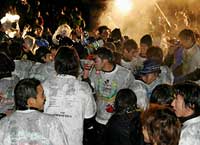|
|
|||||||
|
|
|||||||
|
|||||||
| | Web Japan >> | Trends in Japan >> | Sports >> | Dreaming of J. League Glory | |
|
DREAMING OF J. LEAGUE GLORY Local Communities Back New Soccer Teams (February 4, 2005) The J. League, Japan's professional soccer league, will expand to 30 clubs for its 2005 season, a three-fold increase from the 10 clubs that began the inaugural 1993 season. Unlike Japanese pro baseball, where many teams are named after their corporate sponsors, the J. League was created with the idea of having clubs represent their local communities while eschewing overt displays of corporate sponsorship. This approach has taken root, and new clubs with hopes of breaking into the J. League are now blossoming in a number of communities. Small Towns, Big Dreams Thespa Kusatsu's team name is derived from the word spa (hot spring). The club was established in 2002 with an eye toward breaking into the J. League and includes many players with J. League experience, including former Japan national team goalkeeper Kojima Nobuyuki. Many of the players compete while holding down jobs at the local hot spring resorts - a far cry from the treatment enjoyed by top professional athletes. The club made the jump from the semi-professional Japan Football League (JFL) to J2 in a record span of just three years, its players perhaps motivated by memories of having once been cut from J. League clubs. In keeping with the spirit of a spa town, upon earning promotion the players and local fans celebrated by spraying one another with hot spring water rather than champagne. The club representing Tokushima, an area famous for the tidal whirlpools of the Naruto Straits, has its roots in Otsuka Football Club of the JFL. Ten years ago, 240,000 of Tokushima Prefecture's 800,000 residents signed a petition in support of establishing a J. League club in their area. The initiative was abandoned for a time, but recently the local government injected new life into it by providing capital for the new team. The club earned entry into J2 by winning the JFL championship. Other Local Clubs Waiting in the Wings The reasons for this new wave of soccer clubs include the increased interest in soccer triggered by Japan's co-hosting of the 2002 FIFA World Cup, relatively low annual running costs of ¥1 billion ($10 million) (much lower than the cost of running a baseball team), and the contribution of the clubs to revitalizing communities. The J. League's 100-Year Vision foresees teams representing their localities in other sports as well as soccer, as happens in some European countries. If the current trend for community-based teams continues, it may not be too far-fetched to envision a future in which 100 clubs compete throughout Japan. Copyright (c) 2005 Web Japan. Edited by Japan Echo Inc. based on domestic Japanese news sources. Articles presented here are offered for reference purposes and do not necessarily represent the policy or views of the Japanese Government. |
GETTING A KICK FROM FUTSAL (December 24, 2004) HAVE FOOT, WILL TRAVEL (January 8, 2003) GETTING READY FOR KICK-OFF (February 28, 2002) |
|
|



